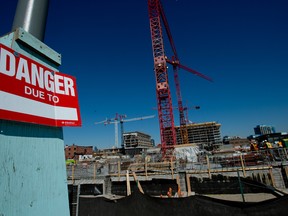The recession hawks are circling as economic expansion nears its 10-year anniversary
Downturns tend to occur every decade or so. With the financial crisis of 2008 still fresh in our minds, are we due for another?

Article content
OTTAWA — Only a few years ago, some analysts were already circling 2018 in bright red ink and warning the end could be near for this round of economic expansion.
Predictions of weaker growth and possibly another recession were common.
It’s the cyclical nature of such downturns to recur roughly every 10 years or so, and the memory of the global financial, economic and market collapse of 2008-09 is still vivid among investors and regulators.
Those same predictions have been cropping up again of late, begging the question: Is another recession even possible so soon? Maybe, but it’s unlikely at this stage.
What many economists and policymakers do expect, however, is weaker — but possibly more sustainable — growth over the next few years.
That shift seems to have already arrived.
Gross domestic product, for example is suddenly looking more subdued than predicted. After average monthly gains of 0.4 per cent from January to June, or 4.8 per cent overall on an annualized basis, and following equally impressive growth of four per cent in the last six months of 2016, output turned flat in July, setting a weak tone for the second half of 2017.
“We all knew the economy could not keep up that pace, and it was only a matter of time before it cooled – and July marks the start of that cooling,” BMO Capital Markets said in a note to investors. “(Now) we look for small GDP gains in August and September, lifting annualized growth for all of Q3 above a two-per-cent pace.”
The last major threat to the economy came from the global collapse of oil prices, pulling the country into a temporary recession over the first half of 2015, and marking the first downturn since the Great Recession.
“The economic progress we have seen tells us that the moves we took to ease policy in 2015 were the right thing to do,” Bank of Canada governor Steven Poloz said in a speech last week to a business audience in St. John’s, N.L.
That marked his first public appearance since raising the central bank’s benchmark lending rate by a quarter point on Sept. 6, the second such hike since July, which was the first upward rate adjustment in seven years.
Policy makers are likely to take a pause now, keeping their one-per-cent trendsetting lending rate untouched at its Oct. 25 meeting but focusing on the bank’s quarterly Monetary Policy Report — to be released the same day — to flush out the most recent economic data.
“At a minimum, that additional stimulus is no longer needed. But there is no predetermined path for interest rates from here,” Poloz said. “Monetary policy will be particularly data-dependent in these circumstances and, as always, we could still be surprised in either direction.”
Some observers are more pessimistic in their global forecasts for near-term growth.
“We are on the cusp of a global economic slowdown, and it could have a dire impact across the board, especially for stocks,” writes Michael Lombardi, who heads the Florida-based Lombardi Letter, an online financial and investment site.
“An economic slowdown in the overall global economy, which is happening right now, could be devastating for the stock market,” he warned. “That’s another reason why I’m suggesting that investors with exposure to the North American stock market should tread lightly at this stage of the economic cycle.”
The timing of any major economic slowdown is never a certainty.
“The concern is that when you start off with such a modest growth rate it really doesn’t take too much of a shock to drive the economy into a downturn,” BMO chief economist Douglas Porter said in an interview.
“I happen to believe that there’s nothing on the near-term horizon, at least from an economic sense, to drive the economy into a downturn – nothing on the immediate horizon,” he said. “Of course, there are all kinds of geopolitical issues that we could point to and fret about. But there are not a lot of huge imbalances that would drive the North American economy into reverse developing, just yet.”
At the end of September, the U.S. expansion turned eight-and-a-quarter-years old. So it still has a little ways to run before reaching the 10-year theoretical threshold.
Special to Financial Post









Postmedia is committed to maintaining a lively but civil forum for discussion. Please keep comments relevant and respectful. Comments may take up to an hour to appear on the site. You will receive an email if there is a reply to your comment, an update to a thread you follow or if a user you follow comments. Visit our Community Guidelines for more information.